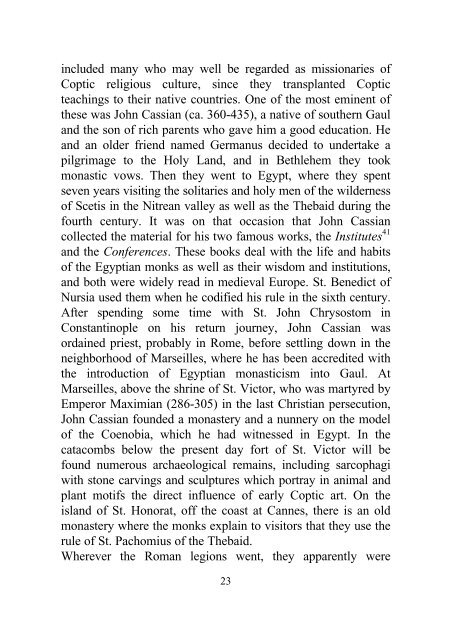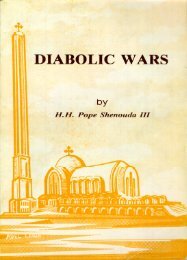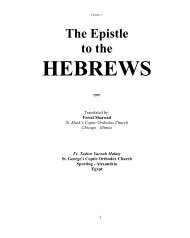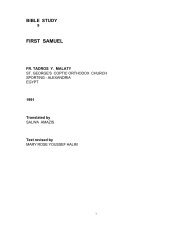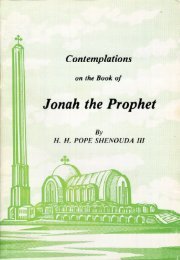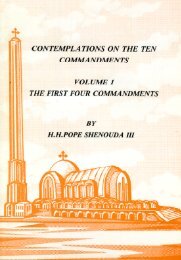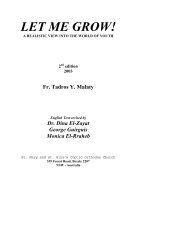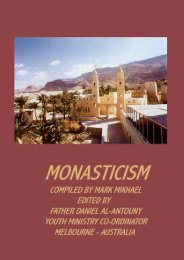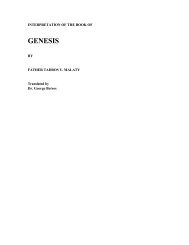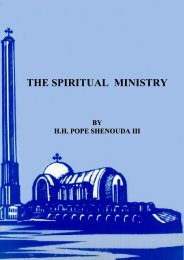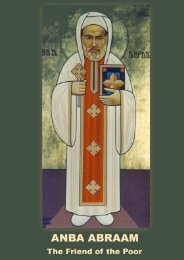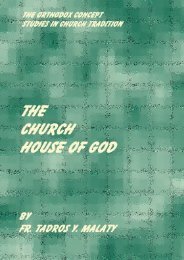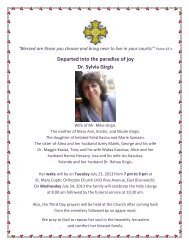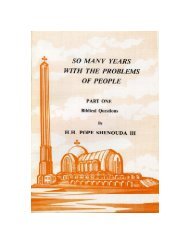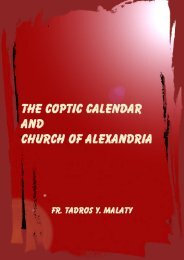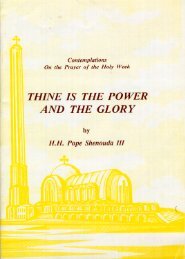the coptic contribution to christian civilisation - Fatherjacob.org
the coptic contribution to christian civilisation - Fatherjacob.org
the coptic contribution to christian civilisation - Fatherjacob.org
Create successful ePaper yourself
Turn your PDF publications into a flip-book with our unique Google optimized e-Paper software.
included many who may well be regarded as missionaries ofCoptic religious culture, since <strong>the</strong>y transplanted Copticteachings <strong>to</strong> <strong>the</strong>ir native countries. One of <strong>the</strong> most eminent of<strong>the</strong>se was John Cassian (ca. 360-435), a native of sou<strong>the</strong>rn Gauland <strong>the</strong> son of rich parents who gave him a good education. Heand an older friend named Germanus decided <strong>to</strong> undertake apilgrimage <strong>to</strong> <strong>the</strong> Holy Land, and in Bethlehem <strong>the</strong>y <strong>to</strong>okmonastic vows. Then <strong>the</strong>y went <strong>to</strong> Egypt, where <strong>the</strong>y spentseven years visiting <strong>the</strong> solitaries and holy men of <strong>the</strong> wildernessof Scetis in <strong>the</strong> Nitrean valley as well as <strong>the</strong> Thebaid during <strong>the</strong>fourth century. It was on that occasion that John Cassiancollected <strong>the</strong> material for his two famous works, <strong>the</strong> Institutes 41and <strong>the</strong> Conferences. These books deal with <strong>the</strong> life and habitsof <strong>the</strong> Egyptian monks as well as <strong>the</strong>ir wisdom and institutions,and both were widely read in medieval Europe. St. Benedict ofNursia used <strong>the</strong>m when he codified his rule in <strong>the</strong> sixth century.After spending some time with St. John Chrysos<strong>to</strong>m inConstantinople on his return journey, John Cassian wasordained priest, probably in Rome, before settling down in <strong>the</strong>neighborhood of Marseilles, where he has been accredited with<strong>the</strong> introduction of Egyptian monasticism in<strong>to</strong> Gaul. AtMarseilles, above <strong>the</strong> shrine of St. Vic<strong>to</strong>r, who was martyred byEmperor Maximian (286-305) in <strong>the</strong> last Christian persecution,John Cassian founded a monastery and a nunnery on <strong>the</strong> modelof <strong>the</strong> Coenobia, which he had witnessed in Egypt. In <strong>the</strong>catacombs below <strong>the</strong> present day fort of St. Vic<strong>to</strong>r will befound numerous archaeological remains, including sarcophagiwith s<strong>to</strong>ne carvings and sculptures which portray in animal andplant motifs <strong>the</strong> direct influence of early Coptic art. On <strong>the</strong>island of St. Honorat, off <strong>the</strong> coast at Cannes, <strong>the</strong>re is an oldmonastery where <strong>the</strong> monks explain <strong>to</strong> visi<strong>to</strong>rs that <strong>the</strong>y use <strong>the</strong>rule of St. Pachomius of <strong>the</strong> Thebaid.Wherever <strong>the</strong> Roman legions went, <strong>the</strong>y apparently were23


